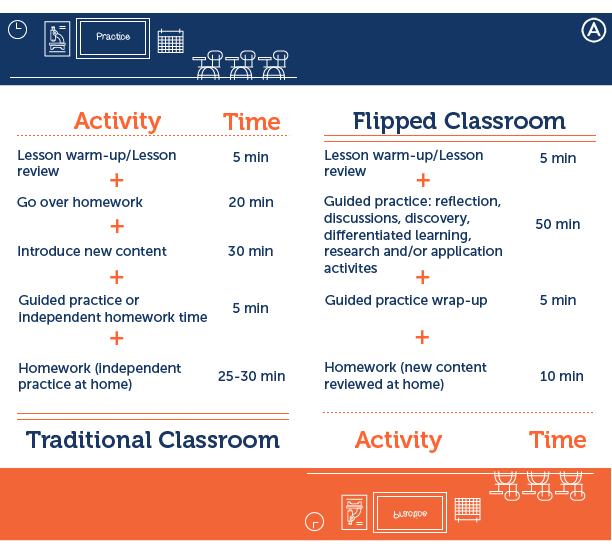Flipped learning is one of the newest educational trends in K-12 classrooms today. The Flipped Model literally flips the way classroom instruction is delivered. Simply put, instead of the teacher using class time primarily for direct instruction, the teacher assigns direct instruction for students to engage in at home and uses class time to apply student learning through guided and independent practice.
This blog is designed to give you a deeper understanding of what flipped learning looks like and how to transition your classroom into a student-centered, flipped learning environment.
What is Flipped Learning?
To see the key differences between the traditional classroom and a flipped classroom, check out the below comparison:

In the flipped classroom example, the direct instruction that introduces new content is delivered as homework in the form of a video, podcast, slideshow, website, or other media. Students take a quiz to check for mastery, and if they are struggling, re-watch the direct instruction. In the classroom, students engage with their teacher and fellow classmates to practice what they have learned. Since the lecture component is done outside of the classroom, students have more valuable face-to-face time to ask questions and practice essential 21st-century skills.
Pros of a Flipped Classroom
In addition to flipping instruction and homework, an effective flipped classroom provides students with opportunities to:
- Develop 21st-century skills such as collaboration, communication, creativity, and critical thinking
- Invest in and take ownership of their learning
- Apply their learning in novel ways with limited teacher guidance
- Engage in hands-on, real-world activities to enhance their interest in the learning materials
As a result, flipped learning offers a personalized learning experience that is quite the opposite of a traditional, teacher-centered, one-size-fits-all classroom.
How to Get Started Flipping Your Classroom
When planning flipped learning instruction, it’s important to include the Four Pillars of F-L-I-P™.
The Four Pillars of F-L-I-P™
Flexible Environment
In a flipped classroom, students must be able to advance at their own pace, and as the teacher, you need to be flexible about your expectations about students’ abilities and timelines for learning. It’s important for students to take ownership of their learning by demonstrating what they know in ways that make sense to them. Flipped learning provides ample opportunities for you to differentiate activities to support the needs of every student.
Learning Culture
In a flipped learning culture, students are at the center of the classroom, while you, the teacher, act as a guide to support them. To help students develop positive self-direction, scaffold classroom activities so students can build from simple to complex tasks independently or with their peers.
Intentional Content
In order for students to fully engage in the flipped learning content, they need to understand why it’s important for them to learn the material in the first place. The best way to do this is to choose content that students can apply to the real world. Schoolwide projects that relate to every subject, virtual field trips, community guest experts, or activities relating to current events are all excellent ways to make learning meaningful to your students.
Professional Educator
While it may seem like your role as a teacher becomes less important in a flipped classroom, it’s the opposite. Though you aren’t giving lectures in your classroom every day, you are the facilitator and guide as your students apply their new knowledge. Make sure you find ways to interact with your students one-on-one in your flipped classroom in order to provide feedback and formatively assess their progress.







